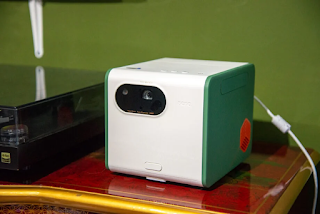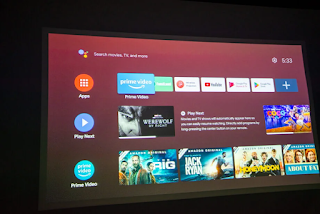BenQ GS50 Specifications
Thanks to its splash-resistant and drop-resistant body, the BenQ GS50 is a bit tougher than the competition, making it a good choice for carrying (especially since it has a bundled case). It comes with an Android TV streaming dongle, although, like many of its competitors, it doesn't support Netflix locally. The image quality is good, with Full HD image resolution and HDR support, but the low brightness of this model means that it should be used in dark conditions as much as you can.
Key features
Full HD image uses XPR technology to upgrade to 1080p.
Media streaming is charged with an Android TV streaming stick that supports most major streaming apps, with the exception of Netflix.
Speakers Dual 5W speakers and 10W speaker provide loud and detailed sound.
Introduction
One of the fun things about having a portable projector is taking it outside in some backyard movie theaters. However, most portable projectors aren't specifically designed for great outdoors, which can be a problem if it starts raining.
With the BenQ GS50, you don't have to worry too much, as it's designed for outdoor use and splash and drop resistant (within limits).
A stylish cubic package with built-in battery and intelligence via Android TV, this is a good-priced and decent portable projector, but it's not that bright.
design
Small cube with splash-resistant outer surface
Android TV via dongle
Good range of outlets
Most portable projectors aren't so sexy to look at, but the BenQ GS50 is different. This projector is equipped with soft-touch plastic in a combination of green, orange and white, which makes it look more fun than most of the competition.
More than just fun, the projector is IPX2 rated, which means it's splash-proof, so rain won't affect it. It can also survive the fall. It is useful if a clumsy person hits the projector while outside.
With a weight of 2.35 kg and 186 × 154 × 146 mm, the GS50 is not the lightest of portable models. It's good, then, for BenQ to provide a solid carrying case for her. Doubling as storage, they provide a great deal of protection to the projector, protecting its lens while not in use.
With any portable projector, how easy it is to set it up is key, and in this regard, the GS50 is very good. It has an adjustable stand at the front that provides different degrees of tilt (step up from the single-position kickstand in XGIMI Halo +).
There is also a standard screw thread, so you can install it on a tripod as well.
The input range is good, with both HDMI, USB-C (DisplayPort) and USB available. Technically, there are two HDMI inputs, and the second is hidden under a hood on the back of the projector.
This port is designed to take the BenQ QS01 Android TV dongle, which is provided in the box. Install this, and the projector will get Wi-Fi, live streaming, and apps. It's a bit strange that these features aren't built-in, especially since the dongle is a bit tricky to get to its place. I had to give my dongle a boost to hold it in place and get the projector to recognize it.
Bluetooth is available, both inward (using the GS50 as a speaker) and outward (for connecting to an external speaker), as well as having an HDMI ARC and a 3.5mm audio output.
A Bluetooth remote control is provided in the box, which has a simple design, supports voice control of the Google Assistant and has responsive buttons.
Volume controls are also available at the top of the projector, along with a power button and button to turn the projector into Bluetooth speaker mode.
Attributes
Auto vertical keystone and autofocus
Amazon Prime and Disney+ are supported, but Netflix is not
Once the BenQ GS50 is turned on and pointed at the screen, it will be triggered by an autofocus routine, which works very well. There is also an automatic vertical deviation, to obtain a square image if the projector is tilted upwards.
This autocorrect is not good. At first, the projector "corrected" itself, but left the horizontal lines look rough and broken. In the end, I turned off automatic mode and set up the projector manually. Full automatic deviation correction on XGIMI Halo + is better, as it does vertical and horizontal correction, and obstacle avoidance in XGIMI Horizon Pro is even better.
Android TV is available via dongle, giving access to the Google Play Store. Here, you can get Disney+, Amazon Prime Video and Paramount Plus, but there is no Netflix app, as it is not supported to play on this device. This is quite a common limitation on portable projectors, although Philips PicoPix MaxTV supports this trend by supporting it.
I didn't find the interface very smooth on this projector, with some lag. Both XGIMI and Philips seem to be more responsive.
performance
That's not that bright.
Decent sound
Good image quality
Occasionally a picture of a jumpy
BenQ does not detect the size of the DMD chip in this DLP monitor. Given the options available, it's unlikely that the chip is fully HD originally. Instead, XPR technology intervenes, shifting the DMD chip around to create a higher resolution image in layers.
This technique works well, and the image looks beautiful and sharp, especially when compared to an older low-resolution projector, such as Nebula Capsule Max.
The brightness is rated at 500 lumens, which is not bright, especially compared to the Philips PicoPix MaxTV or XGIMI Horizon+, both rated at 900 lumens. The difference is most pronounced in bright rooms, and BenQ needs to close the curtains to close them to display a larger picture than that of a mini TV.
When the weather is too dark, it's easy to get an extra 100-inch image from this projector, indoors at dusk, you're probably looking more at a picture with a large TV size of about 80 inches.
Despite being rated at 1080p, it will accept 4K inputs, and supports HDR10 and HLG HDR. It's nice to see both options: a higher miniature resolution looks better than a movie with a low native resolution, and HDR improves contrast, even if the maximum brightness of the projector is not enough to deliver full brightness to a decent TV.
Overall, I was impressed with the image quality. When I saw something bright and colorful, like Coco, I found that the image of the hte was bright and vibrant. More so on Philips PicoPix MaxTV, similar to Halo +.
Watching something moody, like Werewolf by Night, and the BenQ GS50 does a reasonable job. HDR helps to flatten the contrast, although details are still missing in the darkest part of the image, black is more gray than dark black, and there is a slight greenish tinge in the image.
There is little image control, with a selection of preset image modes (sports, movies, etc.); when watching HDR, the photo mode is automatically set to HDR10. There are controls to adjust brightness, contrast, contrast, color, sharpness, and color temperature, but that's your lot.
I noticed a small amount of vibration when stirring quickly, but not enough to cause particular concern.
The sound quality is very good in this projector. It has dual 5W speakers and a 10W speaker that adds this extra rhythm to the movie soundtrack. The BenQ GS50 won't beat decent speakers. However, they are loud and detailed enough, and most importantly for a portable projector, you do not need to connect to a set of external speakers.
The LED light source cannot be replaced but is under warranty for three years or 20,000 hours. Watch for eight hours a day, 20,000 hours will work for almost seven years.
The built-in battery provides up to 2.5 hours of playback, although it depends on the mode in which the projector is operating. It's worth dropping it to low power mode to extend runtime, although this reduces brightness – again, you probably want to wait until darkness falls to use this projector. In general, expect to watch a movie of normal length on a single charge.












